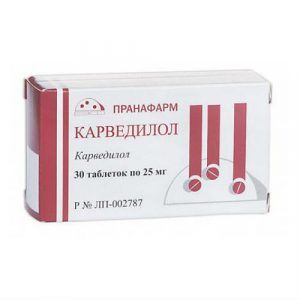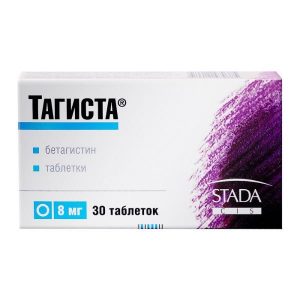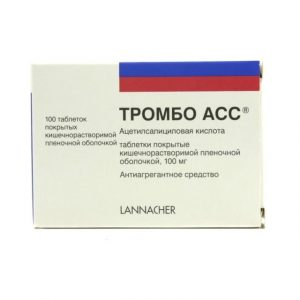Description
Release form
Film-coated tablets.
Packing
90 pcs.
Pharmacological action of
Sildenafil is an effective and selective inhibitor of specific phosphodiesterase type 5 (PDE 5) cyclic guanosine monophosphate (cGMP), an enzyme responsible for the cleavage of cGMP. In addition to the presence of the enzyme in the cavernous pulmonary vas deferens, there is also system. Thus, sildenafil increases the level of cGMP inside the smooth muscle cells of the pulmonary vessels, resulting in a decrease in the tone of the latter. In patients with pulmonary arterial hypertension, this phenomenon can cause vasodilation of the pulmonary vascular bed and, to a lesser extent, vasodilation of the systemic circulation.
Indications
Pulmonary hypertension.
Contraindications
veno-occlusive pulmonary disease
combined use with nitric oxide donors or nitrates in any form
combined use with powerful inhibitors of the isoenzyme CYP3A4 (including ketoconazole, itraconazole and ritonavir)
loss of vision in one eye due to anterior non-arteritic ischemic optic neuropathy
hereditary degenerative diseases of the retina (pigment retinitis)
severe hepatic impairment (class C according to the Child-Pugh classification) stroke or heart attack or severe arterial hypotension (systolic blood pressure less than 90 mm Hg, diastolic blood pressure less than 50 mm Hg)
lactase deficiency, galactosemia or glucose-galactose malabso syndrome rbtsii
age up to 18 years (studies of efficacy and safety have not been conducted)
hypersensitivity to any component of the drug Revazio.
Use in pregnancy and lactation
In animal studies, Revazio did not have a direct or indirect undesirable effect on pregnancy, the development of the embryo / fetus, labor or postnatal development. Since adequate controlled studies of the use of sildenafil in pregnant women have not been conducted, the use of the drug Revacio during pregnancy can only be done if the benefit to the mother outweighs the potential risk to the fetus. It is not known whether lisyldenafil is excreted in breast milk. If it is necessary to use the drug Revacio during lactation, breastfeeding should be discontinued.
Special instructions
To avoid complications, use as directed by your doctor!
The effectiveness of Revacio ® in patients with severe pulmonary hypertension (functional class IV) has not been proven. If the patient worsens during therapy with Revacio ®, consideration should be given to switching to the therapy used to treat this stage of pulmonary hypertension (eg, epoprostenol) (see the section ² ÑDosage and Administration ² Ñ). With the combined use of the drug Revacio with bosentan or other inducers of the CYP3A4 isoenzyme, dose adjustment may be required.
The benefit / risk ratio of sildenafil in patients with functional class I pulmonary hypertension has not been established. Studies on the use of sildenafil in the treatment of secondary pulmonary hypertension, with the exception of pulmonary hypertension associated with connective tissue diseases and residual pulmonary hypertension, have not been conducted.
Hypotension
Sildenafil has a systemic vasodilating effect, resulting in a slight transient decrease in blood pressure. Before prescribing the drug, it is necessary to carefully assess the risk of possible undesirable manifestations of a vasodilating effect in patients with hypotension (AD Cardiovascular complications
) During the post-marketing use of sildenafil for the treatment of erectile dysfunction, adverse events such as serious cardiovascular complications (including myocardial infarction, unstable angina pectoris, sudden cardiac death, ventricular arrhythmia, hemorrhagic stroke, transient ischemic attack, hypertension and hypo enziya), who had a temporal association with the use of sildenafil. The majority of these patients, but not all of them had risk factors for cardiovascular events. Many of these adverse events were observed shortly after sexual activity, and some were noted after taking sildenafil without subsequent sexual activity. It is not possible to establish the existence of a direct relationship between the observed adverse events and the indicated factors or other reasons.
Visual disturbances
Rare cases of the development of anterior non-arteritic ischemic neuropathy of the optic nerve have been noted as a cause of deterioration or loss of vision against the background of the use of all PDE5 inhibitors, including sildenafil. Most of these patients had risk factors such as excavation (deepening) of the optic nerve head, over the age of 50 years, diabetes mellitus, hypertension, coronary heart disease, hyperlipidemia, and smoking. No causal relationship between the intake of PDE5 inhibitors and anterior non-arteritic ischemic optic neuropathy has been identified. The doctor should inform the patient about the increased risk of developing anterior non-arteritic ischemic neuropathy of the optic nerve, if this condition has already been noted. In the event of a sudden loss of vision, patients should immediately receive the necessary medical attention.
Hearing impairment
Some post-marketing and clinical studies report cases of sudden impairment or loss of hearing associated with all PDE5 inhibitors, including sildenafil. Most of these patients had risk factors for sudden impairment or hearing loss. A causal relationship between the use of PDE5 inhibitors and sudden hearing loss or hearing loss has not been established. In case of sudden hearing loss or hearing loss while taking sildenafil, you should immediately consult your doctor.
Bleeding
Sildenafil enhances the antiplatelet effect of sodium nitroprusside, a nitric oxide donor, on human platelets in vitro. There are no safety data on the use of sildenafil in patients with a tendency to bleeding or exacerbation of gastric ulcer and duodenal ulcer, therefore, sildenafil in these patients should be used with caution. The frequency of nosebleeds in patients with PH associated with diffuse connective tissue diseases was higher (sildenafil 12.9%, placebo 0%) than in patients with primary pulmonary hypertension (sildenafil 3.0%, placebo 2.4%). In patients receiving sildenafil in combination with a vitamin K antagonist, the frequency of nosebleeds was higher (8.8%) than in patients who did not take a vitamin K antagonist (1.7%).
Influence on the ability to drive a car and control mechanisms
While taking sildenafil, there was no negative effect on the ability to drive a car or other technical means. However, since a decrease in blood pressure, the development of chromatopsy, blurred vision, etc., are possible when taking sildenafil side effects, you should carefully consider the individual effect of the drug in these situations, especially at the beginning of treatment and when changing the dosage regimen.
Composition
1 tablet contains 20 mg of sildenafil as
citrate excipients: microcrystalline cellulose, calcium hydrogen phosphate anhydrous, croscarmellose sodium, magnesium stearate, shell: Opadry white (OY-LS-28914), Opadry transparent -A), purified water.
Dosage and administration of
Revazio is taken orally. The recommended dose of Revazio is 20 mg 3 times / day. with an interval of about 6-8 hours, regardless of food intake. The maximum recommended dose is 60 mg. Elderly patients: dose adjustment not required.
Side effects of
Adverse events with Revazio therapy were observed in 1% of patients. Side effects according to the MedDRA classification system for organ systems and frequency: very frequent (> 1/10), frequent (> 1/100, <1/10), rare (> 1/1000, <1/100) and very rare, the frequency of which cannot be determined on the basis of available data. Infections and infestations: frequent: inflammation of the subcutaneous tissue, influenza, unspecified sinusitis. From the hematopoietic system: frequent: unspecified anemia. Metabolism and nutrition: frequent: fluid retention. Mental disorders: frequent: insomnia, anxiety. From the central nervous system: very frequent: headache frequent: unspecified migraine, tremor, paresthesia, unspecified burning sensation, hypoesthesia. From the side of the organ of vision: frequent: hemorrhage in the retina of the eye, unspecified visual impairment, blurred vision, photophobia, chromatopsia, cyanopsia, inflammation of the eyes, redness of the eyes rare: decreased visual acuity, diplopia, impaired eye sensitivity. On the part of the organ of hearing and the labyrinth: frequent: vertigo very rare: sudden deafness. Vascular disorders: very frequent: hyperemia. From the respiratory system: frequent: unspecified bronchitis, nosebleeds, unspecified rhinitis, cough, nasal congestion. From the digestive system: very frequent: diarrhea, dyspepsia frequent: unspecified gastritis, unspecified gastroenteritis, gastroesophageal reflux disease, hemorrhoiditis, bloating, dry mouth. From the skin and subcutaneous tissues: frequent: alopecia, erythema, night sweats rare: skin rash. From the musculoskeletal system: very frequent: pain in the extremities frequent: myalgia, back pain. From the reproductive system and mammary gland: frequent: gynecomastia is very rare: priapism, prolonged erection. General disorders and reactions at the injection site: frequent: fever. The total frequency of discontinuation of Revazio treatment at a recommended dose of 20 mg 3 times / day. was low and did not differ from that in the placebo group (2.9%). In a placebo-controlled study, the effect of adjuvant therapy with Revazio was studied as a supplement to iv administration of epoprostenol. 134 patients with LH received Revazio in daily doses from 20 mg to 80 mg 3 times / day. and epoprostenol, and 131 patients received placebo and epoprostenol. The duration of treatment was 16 weeks. The overall frequency of discontinuation of therapy due to adverse events in the sildenafil / epoprostenol group was 5.2% compared with 10.7% in the placebo / epoprostenol group. Drug interactions The effect of other drugs on the pharmacokinetics of sildenafil In vitro studies of Sildenafil metabolism occurs mainly under the influence of P45o cytochrome isoenzymes: CYPZA4 (the main pathway) and the serum pathway inhibit minor , and inductors – to increase its clearance. In vivo studies It has been established that in patients with LH, the clearance of sildenafil decreases and / or its bioavailability increases after oral administration with the combined use of substrates of the CYPZA4 isoenzyme and combination of substrates of the CYPZA4 isoenzyme and P-blockers. The pharmacokinetics of sildenafil in patients with PH was statistically significantly changed only under the influence of these drugs. AUC of sildenafil in patients receiving substrates of CYP3A4 isoenzyme or substrates of CYP3A4 isoenzyme in combination with beta-blockers, was 43% and 66% higher, respectively, than in patients who did not take similar drugs. The AUC of sildenafil when applied at a dose of 80 mg three times a day was 5 times higher than when prescribed in a dose of 20 mg 3 times a day. In studies of interaction with CYPZA4 isoenzyme inhibitors such as saquinavir and erythromycin (excluding more potent CYPZA4 isoenzyme inhibitors such as ketoconazole, itraconazole, ritonavir), AUC of sildenafil increased in this concentration range. In a study on healthy male volunteers, the use of the bosentan endothelin antagonist, which is a moderate inducer of the CYP3A4, CYP2C9 and possibly CYP2C19 isoenzymes, in equilibrium (125 mg 2 times a day) led to a decrease in AUC and Cmaxsildenafil in equilibrium (80 mg 3 times a day) by 62.6% and 55.4%, respectively. Although co-administration of the two drugs was not accompanied by clinically significant changes in blood pressure in the lying and standing positions and was well tolerated by healthy volunteers, sildenafil and bosentan should be used with caution. The use of ritonavir (500 mg 2 times a day), an HIV protease inhibitor and a powerful inhibitor of the CYP3A4 isoenzyme, in combination with sildenafil (100 mg once) led to an increase in Cmax of sildenafil by 300% (4 times) and AUC by 1000% (in 11 times). After 24 hours, the concentration of sildenafil in the blood plasma was about 200 ng / ml versus 5 ng / ml with the appointment of only sildenafil, which is consistent with information about the pronounced effect of ritonavir on the pharmacokinetics of various substrates of cytochrome P450. The combined use of sildenafil with ritonavir is not recommended. The combined use of saquinavir (1200 mg 3 times a day), an HIV protease inhibitor and CYPZA4 isoenzyme, with sildenafil (100 mg once) leads to an increase in Cmax of sildenafil by 140% and AUC by 210%, respectively. Sildenafil did not affect the pharmacokinetics of saquinavir. With the combined use of sildenafil with saquinavir, dose adjustment is not required. More potent inhibitors of the CYPZA4 isoenzyme, such as ketoconazole and itraconazole, may have a more pronounced effect on the pharmacokinetics of sildenafil. With a single dose of 100 mg sildenafil during erythromycin therapy, which is a specific inhibitor of the CYP3A4 isoenzyme, an equilibrium state (500 mg 2 times a day for 5 days) revealed an increase in AUC of sildenafil by 182%. With the combined use of sildenafil with erythromycin, dose adjustment is not required. In healthy male volunteers, azithromycin (500 mg / day for 3 days) did not affect AUC, Cmax, Tmax, elimination rate constant or T1 / 2 of sildenafil and its main circulating metabolite. Cimetidine (800 mg), a cytochrome P450 inhibitor and non-specific inhibitor of the CYP3A4 isoenzyme, caused an increase in plasma concentrations of sildenafil (50 mg) in healthy volunteers by 56%. A single dose of antacids (magnesium hydroxide and aluminum hydroxide) did not affect the bioavailability of sildenafil. The combined use of oral contraceptives (ethinyl estradiol 30 μg and levonorgestrel 150 μg) did not affect the pharmacokinetics of sildenafil. Effect of sildenafil on the pharmacokinetics of other drugs In vitro studies Sildenafil is a weak inhibitor of the isoenzymes CYP1A2, CYP2C9, CYP2C19, CYP2D6, CYP2E1 and CYP A4 cytochrome P450 150 IC50. In vivo studies Sildenafil has an effect on the MO / cGMP system and enhances the hypotensive effect of nitrates. Its combined use with nitric oxide donors or nitrates in any form is contraindicated. With the simultaneous administration of the alpha-blocker doxazosin (4 mg and 8 mg) and sildenafil (25 mg, 50 mg and 100 mg) in patients with benign prostatic hyperplasia an additional decrease in systolic / diastolic blood pressure in the supine position was 7/7, 9/5 and 8/4 mm Hg. Art., and in a standing position – 6/6, 11/4 and 4/5 mm RT. Art., respectively. When prescribing sildenafil to patients receiving doxazosin, rare cases of development of orthostatic hypotension, accompanied by dizziness, but not fainting, were noted. The use of sildenafil in patients taking alpha-blockers can lead to clinically significant arterial hypotension in patients with blood pressure lability. When studying the interaction of sildenafil (100 mg) with amlodipine in patients with arterial hypertension, an additional decrease in systolic and diastolic blood pressure was observed in the supine position at 8 mm Hg. Art. and 7 mmHg. Art., respectively. A similar decrease in blood pressure was observed with sildenafil alone in healthy volunteers. No evidence of interaction between sildenafil (50 mg) and tolbutamide (250 mg) or warfarin (40 mg), which is metabolized by the CYP2C9 isoenzyme. Sildenafil (50 mg) did not cause an additional increase in bleeding time caused by acetylsalicylic acid (150 mg). Sildenafil (50 mg) did not enhance the hypotensive effect of ethanol in healthy volunteers with a maximum concentration of ethanol in the blood of 80 mg / dl. In healthy volunteers, sildenafil in equilibrium (80 mg 3 times a day) caused an increase in AUC and Cmax of bosentan (125 mg 2 times a day) by 49.8% and 42%, respectively. Sildenafil in a single dose of 100 mg did not affect the equilibrium pharmacokinetics of the HIV protease inhibitors saquinavir and ritonavir, which are substrates of the CYPZA4 isoenzyme. Sildenafil did not have a clinically significant effect on the concentration of oral contraceptives in blood plasma (ethin or estrad iol 30 μg and levonorgestrel 150 μg). Overdose Symptoms: headache, blood tides to the skin, dizziness, dyspepsia, nasal congestion, impaired vision. Treatment: symptomatic. Dialysis does not accelerate the excretion of sildenafil, since the latter actively binds to blood plasma proteins and is not excreted by the kidneys. Storage conditions Store the product in a dry place at a temperature not exceeding 30 ° C. Keep out of the reach and sight of children. Shelf life 5 years Deystvuyushtee substance Sildenafil Terms and conditions prescription dosage form tablets Indications Indications Indications Indications Indications circulatory




